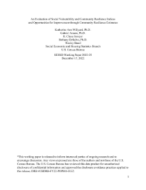
An official website of the United States government
Here’s how you know
Official websites use .gov
A .gov website belongs to an official government organization in the United States.
Secure .gov websites use HTTPS
A lock (
) or https:// means you’ve safely connected to the .gov website. Share sensitive information only on official, secure websites.
-
//
- Census.gov /
- Library /
- Census Working Papers /
- An Evaluation of Social Vulnerability and Community Resilience Indices
An Evaluation of Social Vulnerability and Community Resilience Indices and Opportunities for Improvement through Community Resilience Estimates
An Evaluation of Social Vulnerability and Community Resilience Indices and Opportunities for Improvement through Community Resilience Estimates
Purpose:
This paper describes how the U.S. Census Bureau’s Community Resilience Estimates (CRE) program provides an enhanced method of identifying communities most vulnerable and most resilient to a disaster.
Methods:
Through small area modeling and using auxiliary data sources, the CRE program enhances survey estimates, and reduces margins of error, especially for small geographic areas. CRE are model-based enhancements of American Community Survey (ACS) estimates, created by integrating additional information from the U.S. Census Bureau’s Population Estimates Program (PEP). CRE methodology employs statistical modeling techniques to combine supplemental information with survey data to produce estimates that are more reliable. CRE are broadly consistent with ACS direct survey estimates, but with help from other data sources, CRE are more precise than ACS direct survey estimates alone.
Main Points:
- CRE is more precise and timely than existing measures of social vulnerability and community resilience.
- Because high point estimates are often related to high sampling error, areas described as high-risk using existing measures of social vulnerability and community resilience have higher sampling error than areas not considered high-risk.
- CRE provides a stable measure of social vulnerability and community resilience for planning and to distribute community resources.
- Because it uses microdata, CRE is the only measure to provide both estimates of social vulnerability along with measures of reliability, which are necessary to statistically determine if there is a significant difference between two areas or points of time.
Recommendations:
- Use CRE to make geographic comparisons in community resilience and social vulnerability.
- Define vulnerable communities as tracts or counties with a portion of the population with 3 or more vulnerability indicators higher than the national average.
- Define resilient communities as tracts or counties with a portion of the population with 3 or more vulnerability indicators lower than the national average.
Share
Related Information
Some content on this site is available in several different electronic formats. Some of the files may require a plug-in or additional software to view.
 Yes
Yes
 No
NoComments or suggestions?


Top

